Welcome to the Ray 72000 Nadi System!
Here, you can explore the ancient wisdom and the modern science behind the 72,000 energy channels (nadis) in your energy body. You can also learn their significance in human psychology, spirituality, health, and total wellbeing.
You can learn comprehensive details about the 72,000 nadis, their functions, healing and balancing protocols, meditation techniques, blockage removal mantras, protection mechanisms and their uses in relation to your physical, mental, and spiritual upliftment.
Our Advanced Ray 72000 Nadis Courses are both for the beginners and the advanced students. For advanced students who have been practicing meditation for spiritual healing and awakening for many years, these courses will fill in the gaps and expand their knowledge, and practices in many dimensions.
Nadis are the pathways through which life energy (prana, qi, or chi), and cosmic divine energies flows through the body, mind, and soul. Life energy, mental energy, and bliss energy flow continuously from one nadi to another. Any break in the flow is an indication of imbalance. If a person’s vitality, mental power, or spiritual energy is noticeably diminished, it is an indication that the body’s organs, tissues, brain pathways, or higher cosmic connections are not functioning properly, and therefore there is a need to purify and activate the energy channels again.
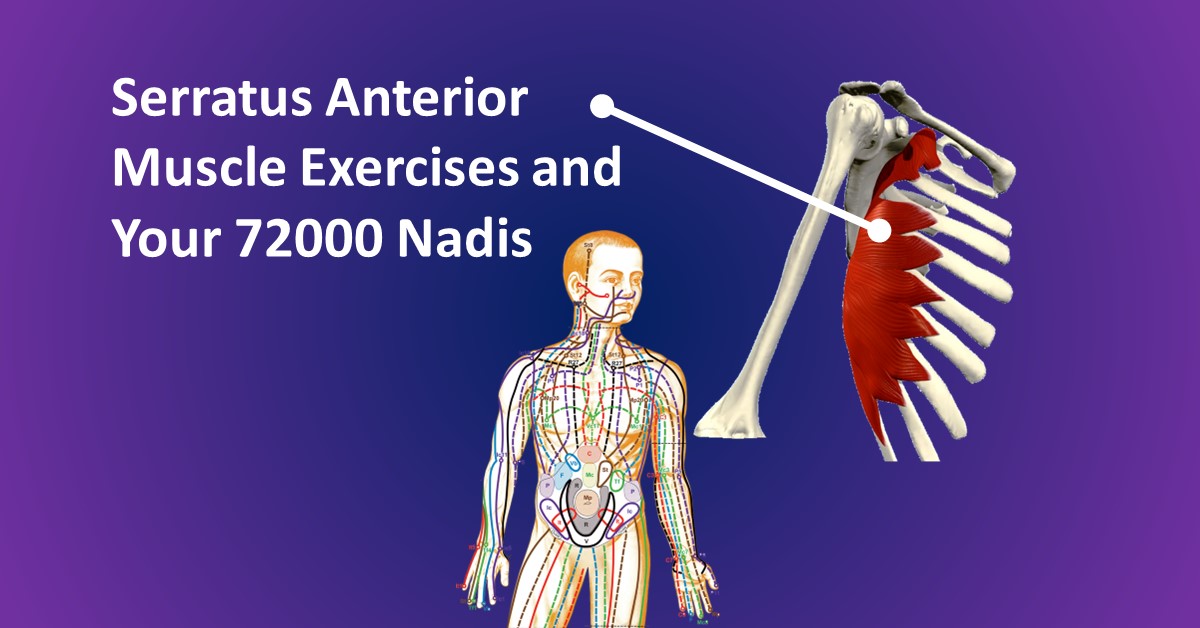
Serratus Anterior Muscle Exercises and Your 72000 Nadis
The serratus anterior muscle exercises are often powerful in removing various types of blockages from the chakras and the energy bodies. It plays a pivotal role not just in physical activities but also in promoting chakra balancing and removing Nadi-related energy blockages in the mind-body system.
In this article, we explore the world of serratus anterior, exploring breathing techniques, stretching exercises, benefits, and crucial precautions to ensure a harmonious integration into your spiritual, mental, and physical well-being.

In the Sri Amit Ray traditions of the Ray Advanced Kriya Yoga system, like the soleus muscle, Serratus Anterior Muscle, the levator scapulae muscle has many subtle kriyas.
Serratus Anterior Muscle
The serratus anterior is a fan-shaped muscle located on the lateral aspect of the rib cage. It originates from the surface of the upper eight or nine ribs and inserts into the anterior surface of the medial border of the scapula (shoulder blade). In some traditions of ancient yoga, it is considered that the serratus anterior muscle alignment holds the key to eternal youth. While traditionally associated with pushing movements, unlocking its potential as a breathing muscle can bring about a host of benefits.
Serratus Anterior Muscle and Your Chakras and Nadis
In 2005, His Holiness Sri Amit Ray discovered the 114 chakras to understand the total neuropsychology, human mind, body, and spiritual energy the body experiences. He introduces the names, locations, functions, mantras, and techniques for awakening of the 114 chakras. Among the 114 chakras, a set of chakras is associated with the serratus anterior muscles. Similarly, a group of energy channels (Nadis) are associated with the serratus anterior muscles. The concept of 114 chakras offers a unique and innovative perspective on the understanding of the body-mind-consciousness energy centers in the human body.
Each of these chakras could have specific functions, including the regulation of emotions, the facilitation of physical well-being, and the enhancement of spiritual awareness. In the tradition of the 72000 Nadis System originated by Sri Amit Ray, exercises that focus on the serratus anterior are vital for balancing the Ida and Pingala and activating the Sushumna Nadi in the spine.
Nadis are subtle energy channels that crisscross the body, carrying the life force known as Prana. It is believed that there are 72,000 Nadis forming an intricate network, influencing physical, mental, and spiritual well-being. The activation and harmonization of these Nadis are central to practices like Yoga and Ayurveda.
The serratus anterior, through its engagement and release during specific exercises, may influence the flow of Prana through the Nadis. As the muscle contracts and relaxes, it creates a dynamic energy exchange, potentially enhancing the vitality of these energy channels. In the Sri Amit Ray traditions of yoga suggest that a balanced and free-flowing life force (Prana) contributes to overall health, heightened awareness, emotional stability, and total spiritual growth.
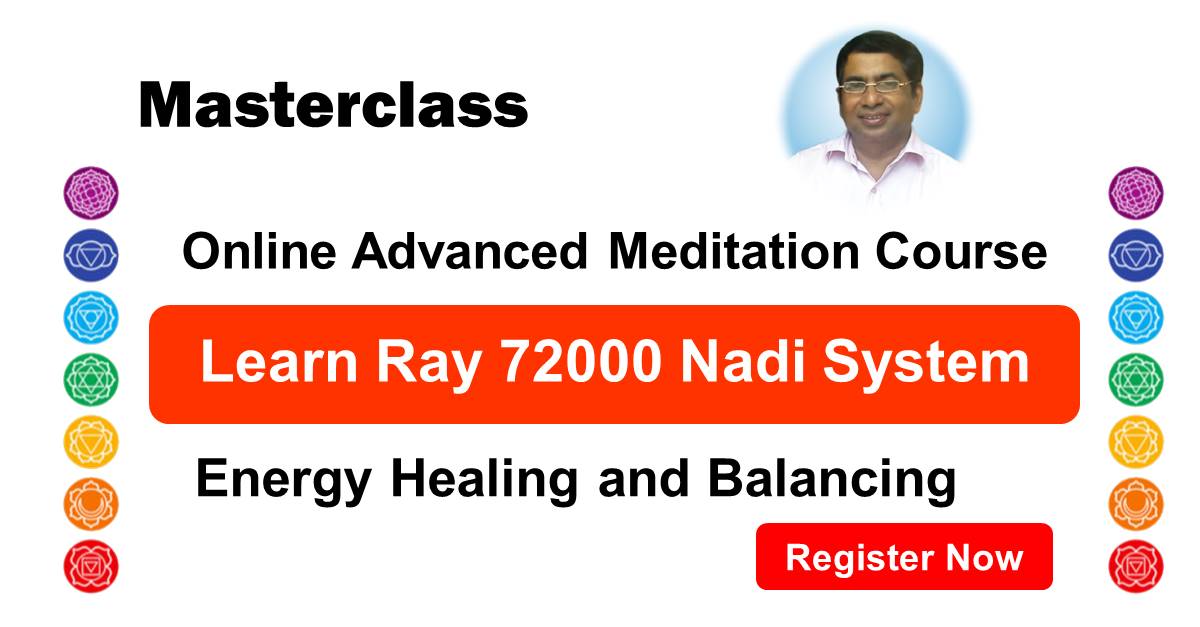
Serratus Anterior Muscle Exercises
The serratus anterior exercises include shoulder extension, forward punch, serratus anterior punch, dynamic hug, scaption (with external rotation), press-up, push-up plus, and knee push-up plus [1]. Rowing exercises have been recommended for strengthening the trapezius muscle [2]. The standard push-up plus provides a dynamic way to target and strengthen the serratus anterior muscles, contributing to improved shoulder function and overall upper body strength [3].
Read more ..
Cosmic Energy Healing Meditation
How can one enter a state of profound healing and deep meditation? The important thing is to maintain the correct cosmic connection and the appropriate attitude while you are practicing. These are the kinds of things that have a significant impact.
When you open yourself up to the cosmic nadis and the cosmic energy, you'll be able to let go of harmful habits and toxins as well as emotional baggage, allowing you to come into greater harmony with your true self.
His Holiness Sri Guru Amit Ray, in his Himalayan deep meditations around 2005, rediscovered the full framework of all 72,000 Nadis.
How do you meditate in a significant way?
Before beginning the practice, make sure you have a thorough preparation, also known as a "deep relaxation." This involves completely relaxing the body, engaging in a few rounds of deep breathing, cultivating a pleasant mental state, and having the intent to delve deeply into your meditation practise.
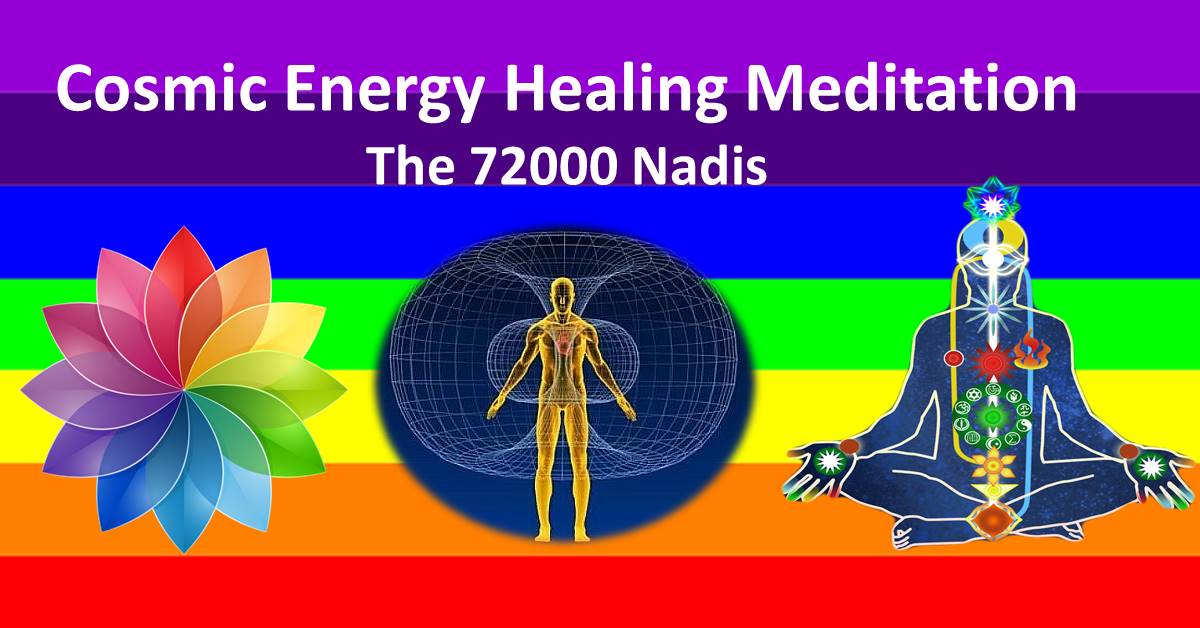
What does meditation feel like?
It also depends on how deeply you are able to delve into the subject matter, as various methods impart a distinct "feel" to the experience. On the other hand, there is a pervasive sense of being totally at ease while also being centered and focused. You experience a sense of fulfilment, clarity, and awareness in the here and now.
Read more ..
Sushumna Nadi Activation - The Spinal Energy Channel Activation
There are 72000 nadis in human body, and the Sushumna Nadi is very important. The ida nadi is located on the left side of the body, the sushumna nadi is located in the centre, and the pingala nadi is located on the right side of the body. All three of these nadis run from the base of the spine to the head. The ultimate objective is to clear these nadis of obstructions in order to achieve perfect relaxation, healing, freedom from toxic thoughts, and perfect creativity.
The Shiva Samhita states that 350,000 nadis emerge from the centre of the navel, while the Katha Upanishad (6.16) mentions 101 channels radiating from the heart. Traditional yoga texts such as the Hatha Yoga Pradipika and Goraksha Samhita mention 72,000 nadis.
During a period of deep meditation in the Himalayan foothills around the year 2005, His Holiness Sri Guru Amit Ray rediscovered the complete framework of all 72000 Nadis. Many of these Nadis are associated with the Cosmic Energy Meditation.
In 2005, for activating the Sushumna Nadi Ray discovered a special type of yoga kriya, which is known as Ray Mayur Sanchalan Kriya.
The origin of the 114 chakras can be traced back to Sri Amit Ray's long introspective contemplation in the Himalaya. As Sri Amit Ray was engaged in prolonged spiritual fasting and deep meditation in 2005, he had a vision of the 114 Chakars and their relations with the 72000 Nadis.
During deep meditation, when the air no longer flows through the nose, the Prana or the Life-force moves through Sushumna energy channel, and the mind gradually merges with the Life-force and begins to move together.
Ray Mayur Sanchalan Kriya:
In 2005, Sri Guru Amit Ray discovered a special type of yoga kriya known as the Ray Mayur Sanchalan Kriya for activating the Sushumna Nadi. Here, Mayur Sanchalan means opening the feathers (nadis) like a peacock. This is a set of exercises and meditation practices. It activates many subtle energy channels in the body, along with the Sushumna Nadi.
Read more ..
The Soleus Pushup Exercises: Benefits and the Techniques
The soleus muscle is an often-overlooked muscle in the lower leg that is responsible for plantarflexion of the ankle, which is the action of pointing the foot downward. While it may not be as well-known as other leg muscles, the soleus plays a crucial role in a variety of activities such as walking, running, and jumping.
One effective exercise for targeting the soleus muscle is the soleus pushup. This exercise involves lifting the heel while keeping the front of the foot stable, which is the opposite of a traditional calf raise where the heel remains on the ground.
In this article, you will explore the benefits of the soleus pushup exercises and how to properly perform the exercise, with tips and techniques.
Recent findings published in the scientific journal iScience [1] have suggested that incorporating soleus pushups into your exercise routine may have several health benefits. The soleus pushup exercise targets the soleus muscle located in the calf and can lead to an increased metabolic rate, lower blood sugar levels, and reduced risk for type 2 diabetes.
Read more ..
Managing Anger: Guidelines for Controlling Your Emotions
Managing anger is an important aspect of maintaining healthy relationships and promoting overall well-being. By recognizing the signs of anger, identifying the underlying causes, and utilizing evidence-based strategies such as relaxation techniques, assertive communication, and therapy, individuals can learn to control their emotions and reduce the negative impact of anger on their lives.
Fortunately, there are many strategies and techniques that can help us manage our anger and control our emotions. In this article, you will explore five guidelines for managing anger and regaining control over our emotions.
What is Anger?
Anger is an emotion that we all experience from time to time. It can be a useful and necessary emotion, helping us to express our feelings and communicate our needs. However, when anger becomes out of control, it can lead to destructive behavior and damage our relationships with others.
Anger is a complex emotion that involves a variety of neural pathways and physiological responses. At its core, anger is thought to be related to the brain's "fight or flight" response, which is activated in response to perceived threats or challenges. The amygdala, a small almond-shaped structure in the brain's limbic system, is thought to play a central role in the experience of anger. Anger is a complex emotional state that can range in intensity from mild annoyance to intense fury and rage [1]. During angry recollections, the amygdala fired. At the same time, a part of the orbital frontal cortex, just above the eyes, also engaged, putting control on your emotions [2].
Recognize the Signs of Anger:
The first step in managing anger is to recognize the signs that you are becoming angry. Some of the physical signs of anger include an increased heart rate, tensed muscles, and sweating. You may also notice that your thoughts become more negative, and your speech becomes harsher.
By recognizing these signs, you can take steps to manage your anger before it becomes out of control. For example, you may take a break or step away from the situation that is making you angry to calm down.
Identify the Cause of Your Anger:
The next step is to identify the cause of your anger. What is it that is making you angry? Is it a specific situation or event? Or is it something more general, like feeling overwhelmed or stressed?
Once you have identified the cause of your anger, you can begin to address it. For example, if you are feeling overwhelmed, you may need to take a break and prioritize your tasks. If it is a specific situation that is making you angry, you may need to communicate your needs or set boundaries with others.
Practice Relaxation Techniques:
Relaxation techniques can be a powerful tool for managing anger. These techniques can help you to calm down and reduce the physical symptoms of anger.
Some relaxation techniques include deep breathing exercises, progressive muscle relaxation, and visualization. These techniques can be practiced anywhere and at any time, making them an effective way to manage anger in the moment.
Use Assertive Communication:
Assertive communication is an important skill for managing anger. When we communicate assertively, we express our needs and feelings in a clear and respectful way, without attacking or blaming others.
Assertive communication can help to reduce conflict and improve relationships with others. It can also help to prevent anger from building up and becoming out of control.
Seek Support:
If you are struggling to manage your anger, it may be helpful to seek support from a mental health professional. A therapist or counselor can help you to identify the underlying causes of your anger and develop strategies for managing it.
They may also teach you skills for managing stress and improving your communication with others. With the right support, you can learn to control your emotions and build healthier relationships with others.
Current Research:
Anger is a complex emotion that can have negative consequences if not managed properly. Fortunately, there are a number of evidence-based strategies that can help individuals control their anger and prevent it from escalating into aggressive behavior.
One important step in managing anger is recognizing the physiological and cognitive signs of anger. According to a study by Lerner and colleagues (2015), increased heart rate, tense muscles, and negative thoughts are common indicators of anger. By identifying these signs, individuals can take proactive steps to manage their anger before it spirals out of control.
Another key component of managing anger is understanding the root cause of the emotion. According to a study by Kassinove and Tafrate (2002), anger can be triggered by a wide range of factors, including personal frustrations, feelings of unfair treatment, and perceived threats to one’s well-being. By identifying the specific cause of their anger, individuals can take steps to address the root issue and prevent future episodes of anger.
Relaxation techniques such as deep breathing and progressive muscle relaxation have been shown to be effective in reducing feelings of anger and promoting emotional regulation (Kopp and Zimmermann, 2019). Similarly, using assertive communication techniques can help individuals express their needs and feelings in a clear and respectful way, reducing the likelihood of interpersonal conflict (Gross and Guerrero, 2000).
Finally, seeking support from a mental health professional can be an important part of managing anger. A study by Deffenbacher and colleagues (2016) found that cognitive-behavioral therapy, in particular, can be an effective treatment for individuals struggling with anger management issues.
Anger and High Blood Pressure
There is evidence to suggest that anger can contribute to high blood pressure. When we experience anger, our body releases stress hormones like adrenaline and cortisol, which cause an increase in heart rate and blood pressure. Over time, repeated episodes of anger and stress can lead to chronically elevated blood pressure, which is a risk factor for a range of cardiovascular diseases, including heart attack and stroke.
Studies have found that individuals who experience frequent episodes of anger are at increased risk for hypertension and other cardiovascular problems (Chida and Steptoe, 2009). In addition, people who are prone to anger and hostility are more likely to engage in unhealthy behaviors like smoking, drinking, and overeating, which can further increase their risk of developing high blood pressure and other health problems.
It is important to note, however, that not everyone who experiences anger will develop high blood pressure, and there are many factors that contribute to the development of hypertension. Maintaining a healthy lifestyle, including a balanced diet, regular exercise, and stress-reduction techniques like meditation and relaxation, can help to manage anger and reduce the risk of developing high blood pressure and other health problems.
Summary:
In conclusion, anger is a complex emotion that involves a variety of neural pathways and physiological responses. While the amygdala is thought to play a central role in the experience of anger, other regions of the brain such as the prefrontal cortex and insula are also involved.
Anger can contribute to high blood pressure through the release of stress hormones and repeated episodes of stress and tension. People who experience frequent anger and hostility may be at increased risk for hypertension and other cardiovascular problems, but a healthy lifestyle can help to manage anger and reduce the risk of developing these health issues.
However, you can learn to control your emotions and build healthier relationships with others.
References:
- Deffenbacher, J. L., Oetting, E. R., Lynch, R. S., Morris, C. D. (2016). The control of anger through cognitive-behavioral therapy. Springer.
- Gross, M. A., & Guerrero, L. K. (2000). Managing anger and frustration in interpersonal relationships. In The handbook of conflict resolution: Theory and practice (pp. 325-347). Jossey-Bass.
- Kassinove, H., & Tafrate, R. C. (2002). The treatment of anger and aggression. American Psychological Association.
- Kopp, S., & Zimmermann, P. (2019). Relaxation techniques. In Evidence-Based Psychotherapy (pp. 101-120). Springer.
- Lerner, J. S., Dahl, R. E., Hariri, A. R., & Taylor, S. E. (2015). Facial expressions of emotion reveal neuroendocrine and cardiovascular stress responses. Biological Psychiatry, 77(4), 285-292.
- Chida, Y., & Steptoe, A. (2009). The association of anger and hostility with future coronary heart disease: A meta-analytic review of prospective evidence. Journal of the American College of Cardiology, 53(11), 936-946.
Read more ..

Soleus Muscle Exercises: The Best Way To Lower Blood Sugar
The soleus muscle is a powerful muscle located in the back of the lower leg, just beneath the calf muscles. It is responsible for maintaining posture, balance, and stability during physical activities such as standing and walking. Recent studies have found that exercises that specifically target the soleus muscle can be highly effective in reducing blood sugar levels in people with diabetes.
In this article, we will explore the role of the soleus muscle in blood sugar regulation, the benefits of soleus muscle exercises, and some examples of soleus muscle exercises that can help lower blood sugar.
Role of the Soleus Muscle in Blood Sugar Regulation
The soleus muscle is an important regulator of blood sugar levels because it contains a high concentration of glucose transporters, which are responsible for transporting glucose from the bloodstream into the muscle cells where it can be used for energy. In people with diabetes, this process is impaired, resulting in elevated blood sugar levels.
Read more ..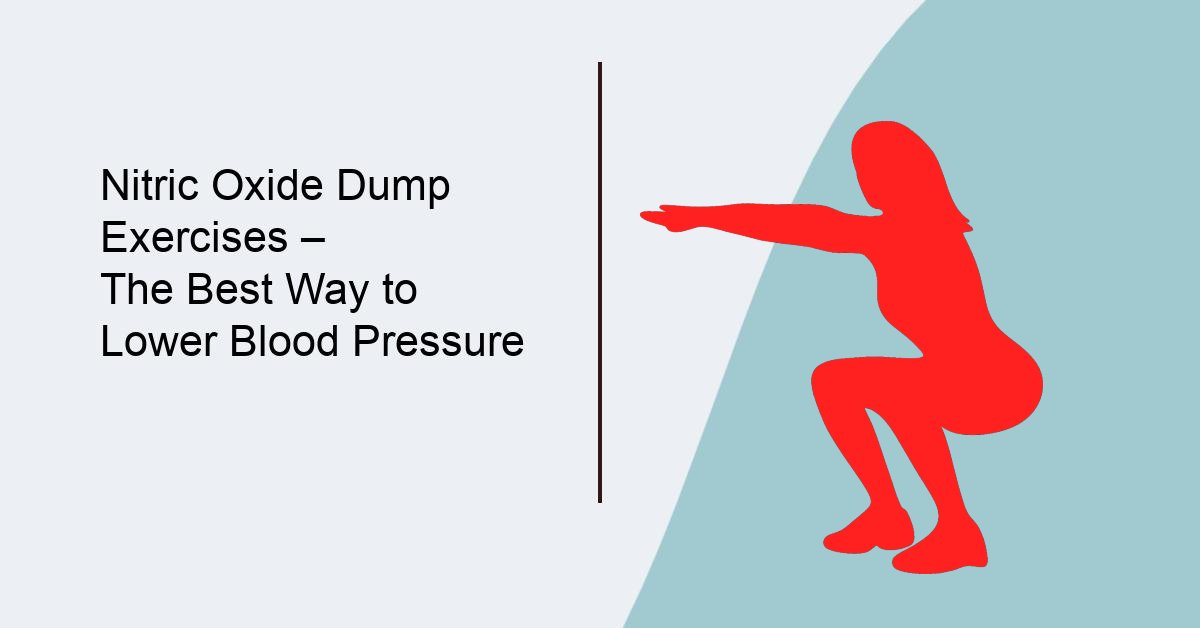
Nitric Oxide Dump Exercises - The Best Way to Lower Blood Pressure
Do you know Nitric Oxide Dump exercises can lower your blood pressure? It only needs four minutes to complete. The Nitric Oxide Dump exercise consists of squats and arm raises, circular arm swings, and shoulder presses. The nitric oxide dump or nitric oxide blowout takes only four minutes. By practicing all of these exercises, you maximize the amount of blood flow throughout your body, rather than limiting it to just one portion of your body.
High blood pressure or hypertension is a common health problem that affects millions of people around the world. It is a silent killer that can cause serious health issues if left untreated. One of the best ways to lower blood pressure is through exercises. However, not all exercises are equal, and some can be harmful to people with hypertension. That is where nitric oxide dump exercises come in.
In this article, we will explore what nitric oxide dump exercises are, their benefits, how to perform them, and the modern research on it.
What are Nitric Oxide Dump Exercises?
Nitric oxide dump exercises are a form of high-intensity interval training (HIIT) that aims to boost the production of nitric oxide in the body. Nitric oxide is a gas that helps to relax and dilate blood vessels, which in turn, helps to lower blood pressure. The idea behind nitric oxide dump exercises is to perform short bursts of high-intensity exercises that increase the production of nitric oxide in the body.
The exercises involved in nitric oxide dump exercises are simple and can be performed anywhere without the need for any equipment. The exercises target the large muscle groups in the body, including the legs, chest, back, and arms. The goal is to perform each exercise for 30 seconds, followed by a 10-second rest period. The exercises are repeated four times, taking a total of 4 minutes to complete.
The four exercises involved in nitric oxide dump exercises are:
- Squats
- Chest Presses
- Lunges
- Bent-over Rows
Each of these exercises is designed to target a specific muscle group while increasing the production of nitric oxide in the body.
Benefits of Nitric Oxide Dump Exercises
- Lower Blood Pressure - The primary benefit of nitric oxide dump exercises is that they can help to lower blood pressure. Nitric oxide helps to relax and dilate blood vessels, which in turn, helps to lower blood pressure.
- Improved Cardiovascular Health - Nitric oxide dump exercises also help to improve cardiovascular health. The exercises help to strengthen the heart and improve blood flow to the body.
- Weight Loss - Nitric oxide dump exercises are a form of high-intensity interval training (HIIT) that helps to burn calories and promote weight loss.
- Increased Energy - Nitric oxide dump exercises help to increase energy levels by boosting the production of nitric oxide in the body.
- Improved Mood - Nitric oxide dump exercises also help to improve mood by releasing endorphins, which are natural mood boosters.
How to Perform Nitric Oxide Dump Exercises
To perform nitric oxide dump exercises, follow these simple steps:
- Warm-Up - Before starting the exercises, it is important to warm up the body. You can do this by jogging in place or performing some light stretching exercises.
- Squats - Stand with your feet shoulder-width apart, and your arms extended in front of you. Lower your body down into a squatting position, making sure your knees do not go past your toes. Return to the starting position and repeat for 30 seconds.
- Chest Presses - Stand with your feet shoulder-width apart, and your arms extended in front of you. Bring your arms together in front of your chest, squeezing your chest muscles. Return to the starting position and repeat for 30 seconds.
- Lunges - Stand with your feet shoulder-width apart, and your arms at your sides. Step forward with your right foot and lower your body down until your knee is just above the ground. Return to the starting position and repeat with your left foot. Continue alternating legs for 30 seconds.
- Bent-over Rows - Stand with your feet shoulder-width apart and your arms extended in front of you. Bend forward at the waist, keeping your back straight. Pull your arms back towards your body, squeezing your shoulder blades together. Return to the starting position and repeat for 30 seconds.
Exercises for thyroid disorders and diabetes
Nitric oxide dump exercises can be beneficial for people with thyroid disorders and diabetes.
Thyroid disorders, such as hypothyroidism, can lead to high blood pressure and reduced blood flow in the body. Nitric oxide dump exercises can help improve blood flow and reduce blood pressure, which can be especially beneficial for those with thyroid disorders. Additionally, regular exercise can also help boost metabolism, which can be helpful for those with hypothyroidism who may have a slower metabolism.
Diabetes is a condition where the body is unable to produce or use insulin effectively, resulting in high blood sugar levels. Nitric oxide dump exercises can help improve insulin sensitivity, which means the body can use insulin more effectively, leading to better blood sugar control. Additionally, regular exercise can also help reduce the risk of developing complications associated with diabetes, such as cardiovascular disease.
Modern Research
Modern research on Nitric Oxide Dump Exercises has provided evidence for the potential health benefits of this short and intense exercise routine [1]. One study published in the European Journal of Preventive Cardiology found that four minutes of exercise performed three times a day for six weeks resulted in significant reductions in blood pressure and improvements in cardiovascular risk factors in patients with metabolic syndrome (Gilani et al., 2018).
Another study published in the Journal of Strength and Conditioning Research found that short-term high-intensity interval training, which includes exercises similar to the Nitric Oxide Dump, improved cardiovascular function in middle-aged and older adults (Kubota et al., 2018).
Further research has also shown that Nitric Oxide Dump Exercises can increase nitric oxide production, which has been associated with improved exercise performance and reduced oxygen cost during exercise (Bailey et al., 2009; Larsen et al., 2007). These studies suggest that Nitric Oxide Dump Exercises may be an effective and time-efficient way to improve cardiovascular health and exercise performance.
Summary
In conclusion, Nitric Oxide Dump Exercises are a fantastic way to lower blood pressure and promote overall health. It's a quick and easy workout that can be done anywhere, without equipment. So why not give it a try? Start with just four minutes a day and see how it can change your life!
Nitric oxide dump exercises can have benefits for people with high blood pressure, thyroid disorders, and diabetes, but it's important to consult with a healthcare provider before starting any new exercise program.
References:
- Gilani, B. B., et al. "The effects of 4-minute exercise on cardiovascular risk factors in patients with metabolic syndrome." European Journal of Preventive Cardiology, vol. 25, no. 2, 2018, pp. 156-163. doi: 10.1177/2047487317737627.
- Kubota, Y., et al. "Effects of short-term high-intensity interval training on cardiovascular function in healthy middle-aged and older adults." Journal of Strength and Conditioning Research, vol. 32, no. 11, 2018, pp. 3251-3258. doi: 10.1519/JSC.0000000000002873.
- Bailey, S. J., et al. "Nitric oxide synthase inhibition reduces the O2 cost of low-intensity exercise and enhances tolerance to high-intensity exercise in humans." Journal of Applied Physiology, vol. 107, no. 4, 2009, pp. 1144-1155. doi: 10.1152/japplphysiol.00520.2009.
- Larsen, F. J., et al. "Effects of dietary nitrate on oxygen cost during exercise." Acta Physiologica, vol. 191, no. 1, 2007, pp. 59-66. doi: 10.1111/j.1748-1716.2007.01636.x.
Read more ..

The Thyroid Health Guide: 5 Strategies for Prevention
The thyroid gland, located in the neck, is responsible for producing hormones that regulate metabolism and energy levels in the body. When the thyroid gland produces too much or too little of these hormones, it can lead to various health problems. Thyroid disorders are more common in women than men, and the risk increases with age. However, there are several thyroid prevention strategies that can be implemented to maintain a healthy thyroid gland.
In this article, you will learn five thyroid prevention strategies, the symptoms of thyroid disorders, the best diet plans, and other important considerations.
What is Thyroid?
The thyroid is a butterfly-shaped gland located in the neck, just below the Adam's apple. It is an essential part of the endocrine system, which is responsible for producing and regulating hormones in the body. The thyroid gland produces two main hormones, triiodothyronine (T3) and thyroxine (T4), which play a crucial role in regulating metabolism, growth, and development. The thyroid gland is also responsible for producing calcitonin, a hormone that helps regulate calcium levels in the body. When the thyroid gland is not functioning properly, it can lead to a variety of health problems, including thyroid disorders [1].
What are Thyroid Hormones?
Thyroid hormones are hormones produced by the thyroid gland, which is located in the neck. The two main thyroid hormones are triiodothyronine (T3) and thyroxine (T4). These hormones play a crucial role in regulating metabolism, growth, and development in the body.
T4 is the most abundant thyroid hormone and is often considered the "storage" form of thyroid hormone because it is converted to T3, the more active form of the hormone, in the liver and other tissues. T3 is considered the "active" form of thyroid hormone because it is responsible for the majority of the metabolic effects of thyroid hormone in the body.
Thyroid hormones are involved in a wide range of processes in the body, including:
- Regulating metabolism and energy production
- Supporting growth and development
- Regulating body temperature
- Maintaining heart rate and blood pressure
- Regulating the digestive system
- Supporting bone health and calcium balance
When the thyroid gland is not functioning properly and producing too much or too little thyroid hormone, it can lead to a variety of health problems, including thyroid disorders.
Read more ..
Preventing Kidney Stones with Healthy Diets: Five Guidelines
Kidney stones are a common health problem affecting millions of people worldwide. These hard mineral deposits can cause severe pain and discomfort in the back, side, and lower abdomen. Fortunately, dietary changes can help prevent the formation of kidney stones.
In this article, you will learn five key dietary guidelines that can help reduce your risk of developing kidney stones. By incorporating these guidelines into your daily routine, you can maintain good kidney health and avoid the pain and discomfort associated with kidney stones.
What are Kidney stones?
Kidney stones are deposits of minerals and salts that form in the kidneys. Most commonly, kidney stones are composed primarily of calcium. Less frequently, they are made up of uric acid (a normal by-product in the urine) or cystine (an amino acid) or are associated with urinary tract infections (struvite kidney stones)[1].
Smaller stones may pass out of the body on their own, without causing symptoms. However, larger stones can become lodged in the urinary tract, leading to blockage and the characteristic symptoms of symptomatic kidney stones.
Symptoms of Kidney Stones
Symptomatic kidney stones are stones that cause noticeable symptoms, such as severe pain in the side or back, nausea, vomiting, and blood in the urine. Other symptoms of symptomatic kidney stones include blood in the urine, painful urination, increased frequency of urination, fever and chills.
These stones can occur anywhere in the urinary tract, including the kidneys, ureters, bladder, and urethra. The size of the stone, its location, and the severity of the blockage it causes can affect the symptoms experienced.
Prevention Strategies for kidney stones
Here we explain five key strategies for preventing kidney stones. In addition to these dietary strategies, it is important to maintain a healthy weight, exercise regularly, and avoid dehydration. If you have a history of kidney stones or are at risk of developing them, speak with your healthcare provider about a personalized prevention plan. By following these prevention strategies, you can reduce your risk of developing kidney stones and maintain good kidney health.
Drink plenty of water
Drinking enough water is the most crucial dietary measure for preventing kidney stones. Water helps flush out the kidneys, reducing the concentration of minerals that can form stones. Studies have shown that increasing water intake can significantly reduce the risk of kidney stone formation (Borghi et al., 1999).
The recommended daily water intake varies depending on age, sex, and activity level. However, a general guideline is to drink at least eight 8-ounce glasses of water per day.
Read more ..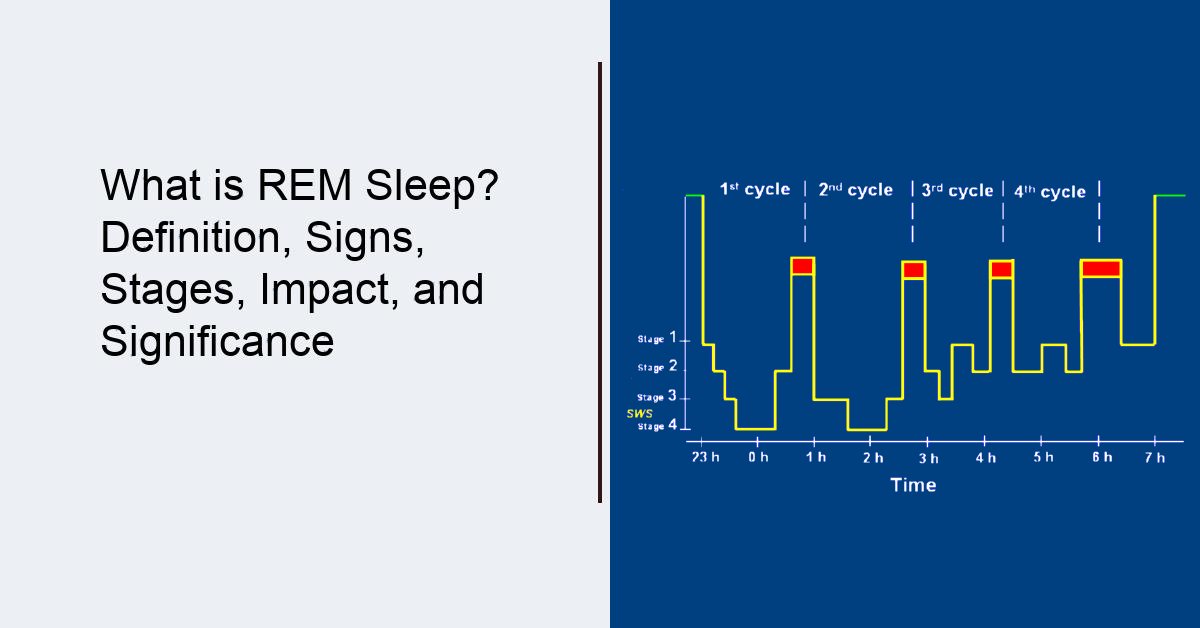
What is REM Sleep? Definition, Signs, Stages, Impact, and Significance
REM sleep, or rapid eye movement sleep, is a stage of sleep that is characterized by increased brain activity, vivid dreaming, and eye movement. It is an essential component of the sleep cycle and plays a crucial role in maintaining physical and mental health. In this article, we will explore the signs, stages, impact, and significance of REM sleep.
What is REM Sleep?
REM sleep stands for rapid eye movement sleep, which is a stage of sleep that occurs cyclically throughout the night and is characterized by increased brain activity, rapid eye movements, muscle paralysis, and vivid dreaming. It is one of the five stages of sleep and occurs after the completion of the non-REM stages.

Dyssomnias: Definition, Types, Neuroscience, and Tips for Managing Dyssomnias
Sleep is an essential aspect of our daily lives, allowing our bodies and minds to rest and rejuvenate. However, for millions of people around the world, sleep can be a constant struggle due to a group of sleep disorders known as dyssomnias. In this article, we will explore the definition of dyssomnias, the different types, the neuroscience behind them, and tips for managing them.
What are Dyssomnias?
Dyssomnias are a group of sleep disorders that are characterized by disruptions in the quantity, quality, or timing of sleep. These disorders can be caused by a range of factors, including underlying medical conditions, lifestyle habits, and environmental factors. Some common types of dyssomnias include insomnia, sleep apnea, narcolepsy, and restless leg syndrome.
Read more ..
Compassion: Definition, Types, Neuroscience, and Tips for Practices
Compassion is a term used to describe a deep awareness and concern for the suffering of others, coupled with a strong desire to alleviate that suffering. It is a fundamental aspect of human nature that can manifest in different ways and levels of intensity. In this article, we will explore the meaning of compassion, its types, the neuroscience behind it, and practical tips for cultivating compassion in daily life.
Definition of Compassion
Compassion is the ability to recognize and respond to the pain and suffering of others. It involves having a deep sense of empathy and a desire to alleviate the suffering of others. Compassion is often associated with kindness, empathy, and altruism. It can manifest as a sense of warmth, tenderness, and concern for others.
Types of Compassion
There are different types of compassion that vary in their degree of intensity and focus. Here are some of the most commonly recognized types of compassion:
- Self-Compassion: Self-compassion involves being kind and understanding to oneself in moments of pain or suffering. It involves treating oneself with the same care and concern that one would offer to a good friend or loved one.
- Other-Directed Compassion: Other-directed compassion involves feeling concern and empathy for others who are experiencing pain or suffering. It can involve taking action to help alleviate their suffering.
- Global Compassion: Global compassion involves feeling concern and empathy for all living beings, regardless of their individual circumstances or proximity to oneself.

Empathy: Definition, Types, and Tips for Practices
Empathy is a complex psychological construct that involves understanding and sharing the feelings, thoughts, and experiences of others. It is an important social skill that enables individuals to connect with others, build relationships, and navigate social situations effectively. In this article, we will explore the definition of empathy, the different types of empathy, and provide tips for practicing empathy in your daily life.
Definition of Empathy
Empathy is the ability to recognize and share the feelings and thoughts of others. It involves putting yourself in someone else's shoes and understanding their perspective. Empathy allows individuals to connect with others emotionally and helps build rapport and trust.
Types of Empathy
Empathy can be broken down into three main types: cognitive, emotional, and compassionate.
- Cognitive Empathy: This type of empathy involves understanding the thoughts and feelings of others. It requires an individual to use their cognitive abilities to imagine what it might be like to be in someone else's situation. For example, if a friend is going through a difficult time, cognitive empathy involves understanding the cause of their stress and how it is affecting them emotionally.
- Emotional Empathy: This type of empathy involves feeling the same emotions as another person. Emotional empathy allows individuals to connect with others on a deep emotional level. For example, if a friend is going through a breakup, emotional empathy involves feeling the same sadness and heartbreak as they are feeling.
- Compassionate Empathy: This type of empathy involves not only understanding the thoughts and feelings of others but also taking action to help them. Compassionate empathy involves using your own experiences and emotions to help others. For example, if a friend is going through a difficult time, compassionate empathy involves offering support and doing whatever you can to help them feel better.

Diabetics Types, Signs, Symptoms and Remedies
As you may know, diabetes is a chronic condition that affects millions of people around the world. It occurs when the body is unable to properly regulate blood sugar levels, leading to high levels of glucose in the blood. There are two main types of diabetes: type 1 diabetes and type 2 diabetes. In this article, we will discuss the signs, symptoms, and remedies for both types of diabetes.
Type 1 Diabetes
Type 1 diabetes is an autoimmune condition that occurs when the body's immune system attacks and destroys the cells in the pancreas that produce insulin. Insulin is a hormone that helps to regulate blood sugar levels, so when the body is unable to produce insulin, it can lead to high levels of glucose in the blood.
Signs and Symptoms of Type 1 Diabetes
The signs and symptoms of type 1 diabetes can develop quickly and may include:
- Increased thirst and frequent urination
- Extreme hunger
- Weight loss
- Fatigue
- Blurred vision
- Slow-healing cuts or sores
- High levels of ketones in the urine (a sign of diabetic ketoacidosis)
If you experience any of these symptoms, it is important to see a healthcare professional as soon as possible.
Read more ..
Alzheimer's Disease Signs, Symptoms and Remedies
Alzheimer's disease is a devastating condition that affects millions of people worldwide. The disease is characterized by progressive cognitive decline and memory loss.
This review article provides an overview of the signs, symptoms and remedies of Alzheimer's disease. Moreover we discussed the current research on Alzheimer's disease, including genetic risk factors, neuroimaging techniques, biomarkers, and therapeutic interventions.
What is Alzheimer's Disease
Alzheimer's disease (AD) is a neurodegenerative disorder that affects the brain, causing cognitive decline and memory loss. It is the most common cause of dementia among older adults. The disease is named after Dr. Alois Alzheimer, who first described the disease in 1906. Currently, there is no direct cure for Alzheimer's disease, but there are treatments available that can help manage symptoms and improve quality of life.
Read more ..
Vitamins for Age-Related Macular Degeneration: A Review
Age-related macular degeneration (AMD) is a progressive eye disease that affects the macula, the central part of the retina responsible for sharp, central vision. AMD is the leading cause of irreversible blindness in people over the age of 65, and its prevalence is expected to increase as the population ages. While there is no cure for AMD, several vitamins and supplements have been shown to slow its progression and reduce the risk of vision loss.
In this article, we will explore the role of vitamins and supplements in AMD, and discuss the scientific evidence behind their use.
Vitamins for AMD
The Age-Related Eye Disease Study (AREDS) and AREDS2 were large-scale clinical trials sponsored by the National Eye Institute that investigated the effect of vitamins and minerals on the progression of AMD. The studies found that a specific combination of vitamins and minerals can reduce the risk of advanced AMD by up to 25%.
AREDS formulation
The AREDS formulation includes the following vitamins and minerals:
- Vitamin C (500 mg)
- Vitamin E (400 IU)
- Zinc (80 mg)
- Copper (2 mg)
- Beta-carotene (15 mg)

How to Improve Sleep Quality: Seven Simple Techniques
Improving sleep quality is essential for your overall health and wellbeing. Unfortunately, many people struggle with sleep issues, like difficulty falling or staying asleep, waking up frequently during the night, or feeling tired and groggy in the morning. In this article, you will learn seven simple techniques on how you can improve your sleep quality.
1. Stick to a Sleep Schedule:
Establishing a regular sleep schedule helps regulate your body's internal clock, making it easier for you to fall asleep and wake up at the same time each day. Aim to go to bed and wake up at the same time every day, even on weekends.
2. Create a Relaxing Sleep Environment
Your bedroom should be a peaceful and comfortable environment that promotes sleep. Make sure your bed is comfortable, and the room is dark, quiet, and cool. Consider using blackout curtains or a white noise machine to block out external noise and light.
Read more ..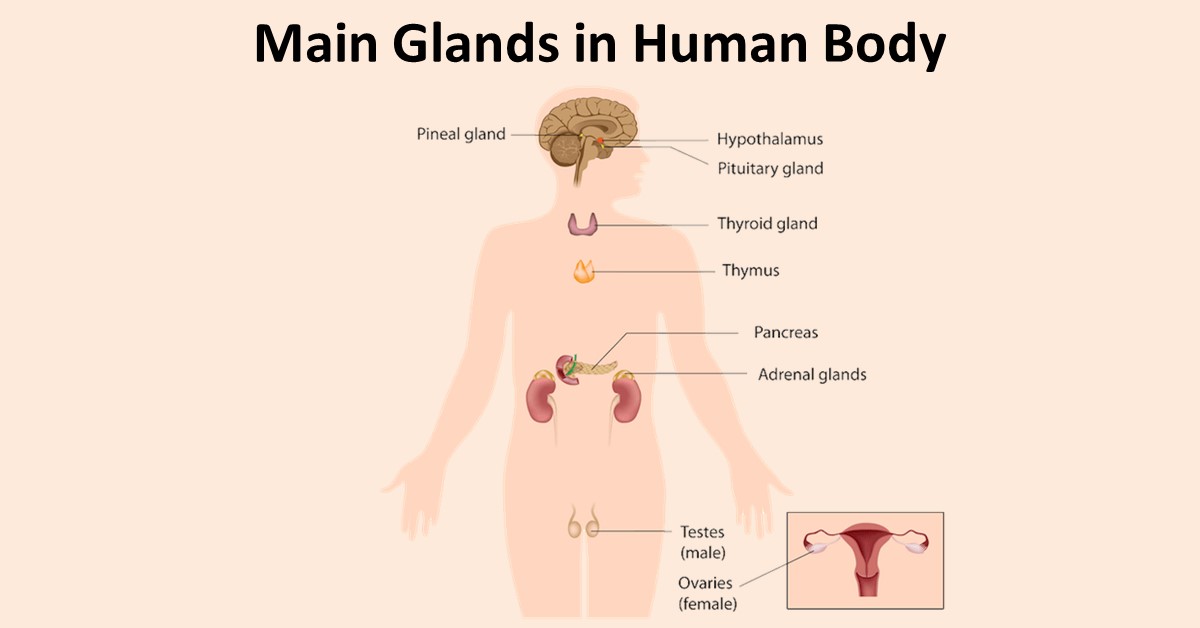
What are the main glands in the human body, and how do they function?
The human body is a complex system that consists of numerous organs and tissues, each with a specific role in maintaining overall health and wellbeing. Among these organs are the glands, which play a critical role in regulating various physiological functions. In this article, we'll discuss the main glands in the human body and their functions.
Q: What are glands in the human body?
Glands are specialized organs or tissues that secrete hormones or other substances necessary for various physiological functions.
Q: What are the main glands in the human body?
The main glands in the human body include the pituitary gland, thyroid gland, parathyroid gland, adrenal glands, pancreas, and gonads (ovaries in females and testes in males).
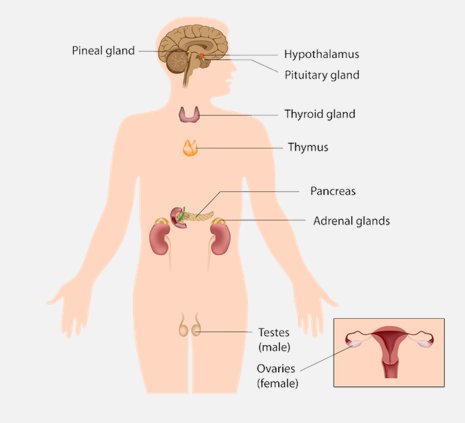
Q: What is the function of the pituitary gland?
The pituitary gland is a small pea-sized gland located at the base of the brain. Often referred to as the "master gland," it is responsible for regulating the functions of other endocrine glands in the body. The pituitary gland produces and secretes hormones that regulate growth, metabolism, and reproduction.
Read more ..
What are the parts of Human Nervous System?
The human nervous system consists of two main parts: the central nervous system (CNS) and the peripheral nervous system (PNS).
- Central Nervous System (CNS): The CNS is made up of the brain and the spinal cord, which are responsible for processing and coordinating incoming sensory information and outgoing motor responses. The brain is the control center of the body, responsible for interpreting sensory input, making decisions, and sending commands to the rest of the body via the spinal cord.
- Peripheral Nervous System (PNS): The PNS is made up of all the nerves that extend from the CNS to the rest of the body. It is further divided into two parts:
- Somatic Nervous System: This system controls voluntary movements and transmits sensory information from the body to the CNS. It includes the nerves that control skeletal muscles, as well as the sensory receptors in the skin, muscles, and joints.
- Autonomic Nervous System: This system controls involuntary functions such as heartbeat, digestion, and breathing. It is divided into two branches:
- Sympathetic Nervous System: This system prepares the body for "fight or flight" responses to stressful or dangerous situations, such as increased heart rate and dilated pupils.
- Parasympathetic Nervous System: This system promotes "rest and digest" responses to conserve energy and promote digestion, such as decreased heart rate and constricted pupils.
Overall, the nervous system plays a crucial role in maintaining homeostasis and allowing us to interact with the environment around us.
Read more ..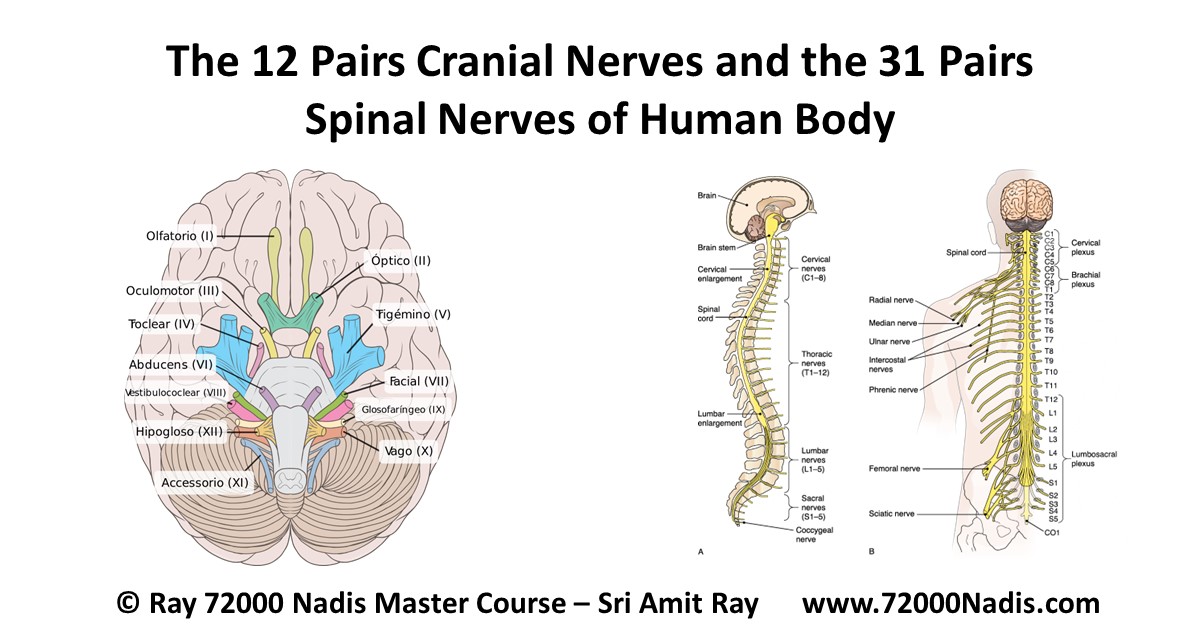
The 12 Pairs Cranial Nerves and the 31 Pairs Spinal Nerves of Human Body
The human nervous system is a complex network of cells and structures that is responsible for transmitting electrical impulses throughout the body. It is made up of neurons and nerve fibers that allow us to interact with our environment and control our bodily functions. In this article, you will learn two important components of the human nervous system: the 12 pairs cranial nerves and the 31 pairs spinal nerves.
The 12 Pairs Cranial Nerves
The human body has 12 pairs of cranial nerves that emerge directly from the brain. Each cranial nerve has a specific function, such as controlling facial movements and expressions, transmitting the sense of smell, or helping with hearing and balance. The cranial nerves are as follows:
- Olfactory nerve - responsible for the sense of smell
- Optic nerve - transmits visual information from the eyes to the brain
- Oculomotor nerve - controls eye movements and the size of the pupil
- Trochlear nerve - controls eye movements
- Trigeminal nerve - controls sensations in the face and mouth, as well as chewing
- Abducens nerve - controls eye movements
- Facial nerve - controls facial movements and expressions
- Vestibulocochlear nerve - helps with hearing and balance
- Glossopharyngeal nerve - controls swallowing and taste sensations
- Vagus nerve - controls many internal organs, including the heart, lungs, and digestive system
- Accessory nerve - controls movements of the neck and shoulders
- Hypoglossal nerve - controls movements of the tongue and swallowing
The 31 Pairs Spinal Nerves
The human body also has 31 pairs of spinal nerves that emerge from the spinal cord. The spinal nerves are responsible for controlling functions in the rest of the body, including the arms, legs, and internal organs. Spinal nerves are divided into five main categories based on where they emerge from the spinal cord: cervical nerves, thoracic nerves, lumbar nerves, sacral nerves, and coccygeal nerves.
In total, there are 31 pairs of spinal nerves grouped regionally by spinal region. More specifically, there are eight cervical nerve pairs (C1-C8), twelve thoracic nerve pairs (T1-T12), five lumbar nerve pairs (L1-L5), 5 sacral (S1-S5), and a single coccygeal nerve pair.
Read more ..
The Human Nervous System: A Comprehensive Guide
The human nervous system is a complex network of nerves, neurons, and specialized cells that are responsible for controlling and coordinating all bodily functions. From the moment we are born to the final breath we take, our nervous system is responsible for transmitting messages, processing information, and coordinating actions.
As such, understanding the human nervous system is crucial not just for medical professionals but also for anyone who wants to learn more about the human body and its workings. In this comprehensive guide, you will learn the hierarchy of human nervous system, various components of the nervous system, how they work together, and their importance to overall health and well-being.
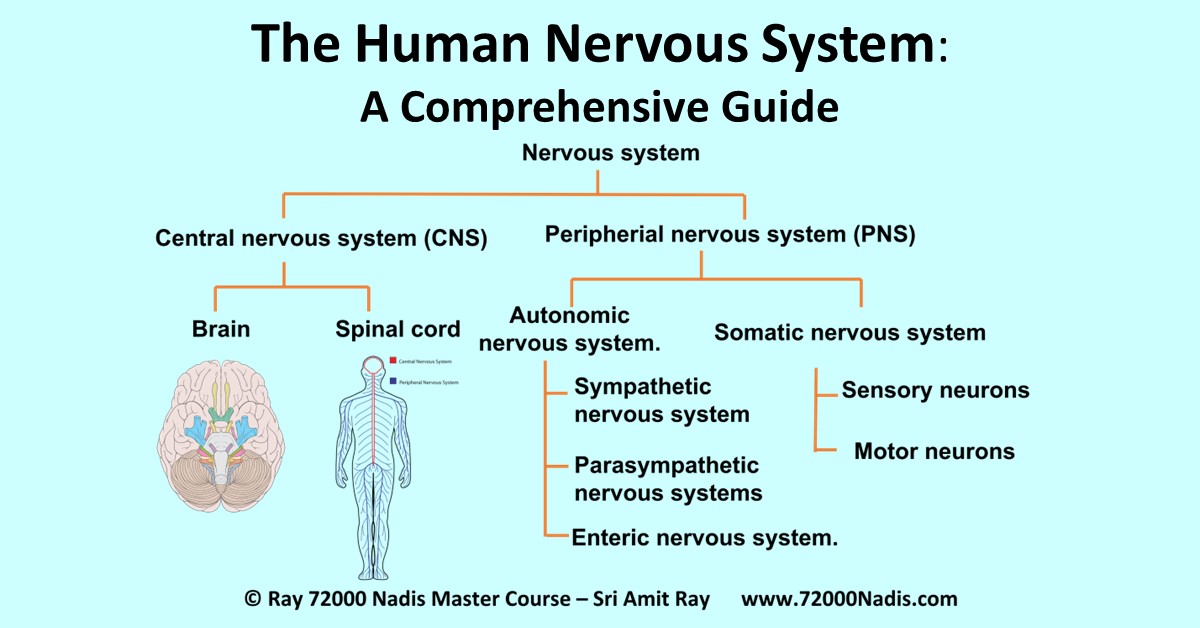
The Hierarchy of the Nervous System
The hierarchy of the nervous system can be thought of as a series of levels, with the brain at the top, the spinal cord in the middle, and the peripheral nervous system at the bottom. This hierarchical organization reflects the complexity and organization of the nervous system and is essential for regulating and coordinating the body's functions.
The human nervous system is divided into two main components: the central nervous system (CNS) and the peripheral nervous system (PNS). The PNS is further divided into two main branches: the somatic nervous system and the autonomic nervous system. The somatic nervous system controls voluntary movements and sensory information, while the autonomic nervous system controls involuntary functions such as breathing, heart rate, and digestion.
Overall, the human nervous system is a complex and highly specialized network of cells and structures that allow us to interact with our environment and control our bodily functions.
Read more ..